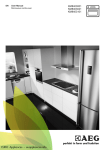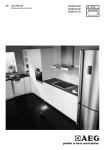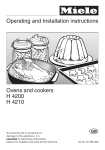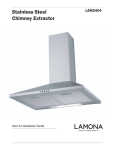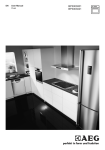Download Microwave combi-oven
Transcript
Microwave combi-oven User Manual LAM7000 2 CONTENTS Safety information Safety instructions Product description Control panel Before first use Daily use Microwave mode Clock functions 2 4 6 7 9 9 12 17 Automatic programmes Using the accessories Additional functions Hints and tips Care and cleaning Troubleshooting Your guarantee 18 19 19 21 41 42 43 Subject to change without notice. SAFETY INFORMATION Before the installation and use of the appliance, carefully read the supplied instructions. The manufacturer is not responsible if an incorrect installation and use causes injuries and damages. Always keep the instructions with the appliance for future reference. Children and vulnerable people safety • • • • • • • This appliance can be used by children aged from 8 years and above and persons with reduced physical, sensory or mental capabilities or lack of experience and knowledge if they have been given supervision or instruction concerning use of the appliance in a safe way and understand the hazards involved. Do not let children play with the appliance. Keep all packaging away from children. Keep children and pets away from the appliance when it operates or when it cools down. Accessible parts are hot. If the appliance has a child safety device, we recommend you activate it. Cleaning and user maintenance shall not be made by children without supervision. Children of less than 3 years should be kept away unless continuously supervised. 3 General Safety • • • • • • • • • • • • • • Only a qualified person must install this appliance and replace the cable. Internally the appliance becomes hot when in operation. Do not touch the heating elements that are in the appliance. Always use oven gloves to remove or put in accessories or ovenware. Before maintenance cut the power supply. Ensure that the appliance is switched off before replacing the lamp to avoid the possibility of electric shock. Do not use a steam cleaner to clean the appliance. Do not use harsh abrasive cleaners or sharp metal scrapers to clean the glass door since they can scratch the surface, which may result in shattering of the glass. If the supply cord is damaged, it must be replaced by the manufacturer, its Authorised Service Centre or similarly qualified persons in order to avoid a hazard. Do not activate the appliance when it is empty. Metal parts inside the cavity can create electric arcing. If the door or door seals are damaged, the appliance must not be operated until it has been repaired by a qualified person. Only a qualified person can carry out any service or repair operation that involves the removal of a cover which gives protection against exposure to microwave energy. Do not heat liquids and other foods in sealed containers. They are liable to explode. Only use utensils that are suitable for use in microwave ovens. When heating food in plastic or paper containers, keep an eye on the appliance due to the possibility of ignition. The appliance is intended for heating food and beverages. Drying of food or clothing and heating of warming pads, slippers, sponges, damp cloth and similar may lead to risk of injury, ignition or fire. 4 • • • • • • If smoke is emitted, switch off or unplug the appliance and keep the door closed in order to stifle any flames. Microwave heating of beverages can result in delayed eruptive boiling. Care must be taken when handling the container. The contents of feeding bottles and baby food jars shall be stirred or shaken and the temperature checked before consumption, in order to avoid burns. Eggs in their shell and whole hard-boiled eggs should not be heated in the appliance since they may explode, even after microwave heating has ended. The appliance should be cleaned regularly and any food deposits removed. Failure to maintain the appliance in a clean condition could lead to deterioration of the surface that could adversely affect the life of the appliance and possibly result in a hazardous situation. SAFETY INSTRUCTIONS Installation WARNING! Only a qualified person must install this appliance. • Remove all the packaging. • Do not install or use a damaged appliance. • Obey the installation instruction supplied with the appliance. • Always be careful when you move the appliance because it is heavy. Always wear safety gloves. • Do not pull the appliance by the handle. • Keep the minimum distance from the other appliances and units. • Make sure that the appliance is installed below and adjacent safe structures. • The sides of the appliance must stay adjacent to appliances or to units with the same height. Electrical connection WARNING! Risk of fire and electrical shock. • All electrical connections should be made by a qualified electrician. • The appliance must be earthed. • Make sure that the electrical information on the rating plate agrees with the power supply. If not, contact an electrician. • Always use a correctly installed shockproof socket. • Do not use multi-plug adapters and extension cables. • Make sure not to cause damage to the mains plug and to the mains cable. Should the mains cable need to be replaced, this must be carried out by our Authorised Service Centre. • Do not let mains cables touch or come near the appliance door, especially when the door is hot. 5 • The shock protection of live and insulated parts must be fastened in such a way that it cannot be removed without tools. • Connect the mains plug to the mains socket only at the end of the installation. Make sure that there is access to the mains plug after the installation. • If the mains socket is loose, do not connect the mains plug. • Do not pull the mains cable to disconnect the appliance. Always pull the mains plug. • Use only correct isolation devices: line protecting cut-outs, fuses (screw type fuses removed from the holder), earth leakage trips and contactors. • The electrical installation must have an isolation device which lets you disconnect the appliance from the mains at all poles. The isolation device must have a contact opening width of minimum 3 mm. • This appliance complies with the E.E.C. Directives. Use WARNING! Risk of injury, burns and electrical shock or explosion. • Use this appliance in a household only. • Do not change the specification of this appliance. • Make sure that the ventilation openings are not blocked. • Do not let the appliance stay unattended during operation. • Deactivate the appliance after each use. • Be careful when you open the appliance door while the appliance is in operation. Hot air can release. • Do not operate the appliance with wet hands or when it has contact with water. • Do not apply pressure on the open door. • Do not use the appliance as a work surface or as a storage surface. • Open the appliance door carefully. The use of ingredients with alcohol can cause a mixture of alcohol and air. • Do not let sparks or open flames to come in contact with the appliance when you open the door. • Do not put flammable products or items that are wet with flammable products in, near or on the appliance. WARNING! Risk of damage to the appliance. • To prevent damage or discoloration to the enamel: – do not put ovenware or other objects in the appliance directly on the bottom. – do not put aluminium foil directly on the bottom of the appliance. – do not put water directly into the hot appliance. – do not keep moist dishes and food in the appliance after you finish the cooking. – be careful when you remove or install the accessories. • Discoloration of the enamel has no effect on the performance of the appliance. It is not a defect in the sense of the warranty law. • Use a deep pan for moist cakes. Fruit juices cause stains that can be permanent. • This appliance is for cooking purposes only. It must not be used for other purposes, for example room heating. • Always cook with the oven door closed. Care and cleaning WARNING! Risk of injury, fire, or damage to the appliance. • Before maintenance, deactivate the appliance and disconnect the mains plug from the mains socket. • Make sure the appliance is cold. There is the risk that the glass panels can break. • Replace immediately the door glass panels when they are damaged. Contact the Service. • Make sure the cavity and the door are wiped dry after each use. Steam produced during the operation of the 6 • • • • • appliance condensates on cavity walls and can cause corrosion. Clean regularly the appliance to prevent the deterioration of the surface material. Remaining fat or food in the appliance can cause fire. Clean the appliance with a moist soft cloth. Only use neutral detergents. Do not use abrasive products, abrasive cleaning pads, solvents or metal objects. If you use an oven spray, obey the safety instructions on the packaging. Do not clean the catalytic enamel (if applicable) with any kind of detergent. Internal light • The type of light bulb or halogen lamp used for this appliance is only for household appliances. Do not use it for house lighting. WARNING! Risk of electrical shock. • Before replacing the lamp, disconnect the appliance from the power supply. • Only use lamps with the same specifications. Disposal WARNING! Risk of injury or suffocation. • Disconnect the appliance from the mains supply. • Cut off the mains cable and discard it. • Remove the door catch to prevent children and pets to get closed in the appliance. PRODUCT DESCRIPTION General overview 1 2 3 4 4 8 5 6 3 2 1 7 1 2 3 4 5 6 7 8 Control panel Electronic programmer Heating element Microwave generator Lamp Fan Shelf support, removable Shelf positions 7 Accessories Baking tray Wire shelf For cakes and biscuits. For cookware, cake tins, roasts. CONTROL PANEL Electronic programmer 1 2 3 4 5 6 7 8 9 10 11 Use the sensor fields to operate the appliance. Sensor field 1 2 3 4 - Function Comment Display Shows the current settings of the appliance. ON / OFF To activate and deactivate the appliance. Heating Functions or Assisted Cooking Touch the sensor field once to choose a heating function or the menu: Assisted Cooking. Touch the sensor field again to switch between the menus: Heating Functions, Assisted Cooking. To activate or deactivate the light, touch the field for 3 seconds. Microwave function To activate the Microwave function. You can use it when the appliance is deactivated. When you use the Microwave function with the function: Duration for more than 7 minutes and in Combi mode, the Microwave power cannot be more than 600 W. 8 Sensor field 5 6 7 8 9 10 11 Function Comment Temperature selection To set the temperature or show the current temperature in the appliance. Touch the field for 3 seconds to activate or deactivate the function: Fast heat up. Down key To move down in the menu. Up key To move up in the menu. OK / Microwave Quick Start To confirm the selection or settings. To activate the Microwave function. You can use it when the appliance is deactivated. Home key To go back one level in the menu. To show the main menu, touch the field for 3 seconds. Time and additional functions To set different functions. When a heating function operates, touch the sensor field to set the timer or the functions: Function Lock, Favourite Programme, Heat + Hold, Set + Go. Minute Minder To set the function: Minute Minder. Display A B C E D A) B) C) D) E) Heating function or Microwave function Time of day Heat-up indicator Temperature or power of the microwave Duration time or end time of a function Other indicators of the display: Function Symbol Minute Minder The function operates. Time of day The display shows the current time. Duration The display shows the necessary time for cooking. End Time The display shows when the cooking time is complete. 9 Symbol Function Temperature The display shows the temperature. Time Indication The display shows how long the heating function operates. Press and the same time to reset the time. at Heat-up Indicator The display shows the temperature in the appliance. Fast Heat Up Indicator The function is active. It decreases the heat up time. Weight Automatic The display shows that the automatic weight system is active or that weight can be changed. Heat + Hold The function is active. BEFORE FIRST USE WARNING! Refer to Safety chapters. Initial Cleaning Remove all accessories and removable shelf supports from the appliance. Refer to "Care and cleaning" chapter. Clean the appliance before first use. Put the accessories and the removable shelf supports back to their initial position. First Connection When you connect the appliance to the mains or after the power cut, you have to set the language, the display contrast, the display brightness and the time of the day. 1. Press 2. Press or to set the value. to confirm. DAILY USE WARNING! Refer to Safety chapters. Navigating the menus 1. Activate the appliance. or to select the menu 2. Press option. 3. Press to move to the submenu or accept the setting. At each point you can go back to the main menu with . 10 The menus in overview Main menu Sym bol Menu item Application Heating Functions Contains a list of heating functions. Assisted Cooking Contains a list of automatic programmes. Favourite Programme Contains a list of favourite cooking programmes created by the user. Basic Settings You can use it to set other settings. Specials Contains a list of additional heating functions. Submenu for: Basic Settings Sym bol Submenu Description Set Time of Day Sets the current time on the clock. Time Indication When ON, the display shows the current time when you deactivate the appliance. Set + Go When ON, in the Select Options window you can choose the function: Set + Go. Heat + Hold When ON, in the Select Options window you can choose the function: Heat + Hold. Extra Time Activates and deactivates the time extension function. Display Contrast Adjusts the display contrast by degrees. Display Brightness Adjusts the display brightness by degrees. Set Language Sets the language for the display. Buzzer Volume Adjusts the volume of press-tones and signals by degrees. Key Tones Activates and deactivates the tone of the touch fields. It is not possible to deactivate the tone of the ON / OFF touch field. Alarm/Error Tones Activates and deactivates the alarm tones. Service Shows the software version and configuration. Factory Settings Resets all settings to factory settings. 11 Heating Functions Heating function Application True Fan Cooking To bake on up to 2 shelf positions at the same time and to dry food. Set the temperature 20 - 40 °C lower than for the function: Conventional Cooking. Pizza Setting To bake food on 1 shelf position for a more intensive browning and a crispy bottom. Set the temperature 20 - 40 °C lower than for the function: Conventional Cooking. Conventional Cooking To bake and roast food on 1 shelf position. Slow Cooking To prepare tender, succulent roasts. Bottom Heat To bake cakes with crispy bottom and to preserve food. Grilling To grill flat food and to toast bread. Fast Grilling To grill flat food in large quantities and to toast bread. Turbo Grilling To roast larger meat joints or poultry with bones on 1 shelf position. Also to make gratins and to brown. Specials Heating function Application Bread Baking To bake bread. Au Gratin For dishes such as lasagna or potato gratin. Also to gratinate and brown. Dough Proving For controlled rising of yeast dough before baking. Plate Warming To preheat your plate for serving. Preserving To make vegetable preserves such as pickles. 12 Heating function Application Drying To dry sliced fruit (e.g. apples, plums, peaches) and vegetables (e.g. tomatoes, zucchini, mushrooms). Keep Warm To keep food warm. Defrost To defrost frozen food. Frozen Foods To make your convenience food like e.g. French Fries, Wedges, spring rolls crispy. Activating a heating function Energy saving 1. 2. 3. 4. 5. 6. 7. The appliance contains features which help you save energy during everyday cooking: Activate the appliance. Select the menu: Heating Functions. Press to confirm. Set a heating function. Press to confirm. Set the temperature. to confirm. Press Heat-up indicator When you activate a heating function, the bar on the display comes on. The bar shows that the temperature increases. Fast Heat Up Indicator This function decreases the heat-up time. for 3 To activate the function, hold seconds. The heat-up indicator alternates. • Residual heat – When the heating function or programme operates, the heating elements are deactivated 10% earlier (the lamp and fan continue to operate). For this feature to operate, the cooking time must be longer than 30 minutes or you must use the clock functions (Duration, End Time). – When the appliance is off, you can use the heat to keep food warm. The display shows the remaining temperature. • Cooking with the lamp off - touch and for 3 seconds to deactivate the hold lamp during cooking. Residual heat When you deactivate the appliance, the display shows the residual heat. You can use the heat to keep the food warm. MICROWAVE MODE Microwave Information about operation General: • After you deactivate the appliance, let the food stand for some minutes. Refer to the microwave cooking tables: standing time. • Remove the aluminium foil packaging, metal containers, etc. before you prepare the food. Cooking: 13 • If possible, cook food covered with material suitable for use in the microwave. Only cook food without a cover if you want to keep a crust. • Do not overcook the dishes by setting the power and time too high. The food can dry out, burn or catch fire in some places. • Do not use the appliance to cook eggs in their shells and snails, because they can burst. With fried eggs, pierce the yolks first. • Prick food with "skin" or "peel", such as potatoes, tomatoes, sausages, with a fork several times before cooking so that the food does not burst. • For chilled or frozen food, set a longer cooking time. • Dishes which contain sauce must be stirred from time to time. • Vegetables that have a firm structure, such as carrots, peas or cauliflower, must be cooked in water. • Turn larger pieces after half the cooking time. • If possible, cut vegetables into similarsized pieces. • Use flat, wide dishes. • Do not use cookware made of porcelain, ceramic or earthenware with small holes, e. g. on handles or unglazed bottoms. Moisture going into the holes can cause the cookware to crack when it is heated. Defrosting meat, poultry, fish: below it, or on a defrosting rack or plastic sieve so that the defrosting liquid can run off. • Turn the food after half the defrosting time. If possible, divide and then remove the pieces that have started to defrost. Defrosting butter, portions of gateau, quark: • Do not fully defrost in the appliance, but let them defrost at room temperature. This gives a more even result. Fully remove all metal or aluminium packaging or parts before defrosting. Defrosting fruit, vegetables: • Do not fully defrost fruit and vegetables, which are to be further prepared while raw, in the appliance. Let them defrost at room temperature. • You can use a higher microwave power to cook fruit and vegetables without defrosting them first. Ready meals: • Ready meals in metal packaging or plastic trays with metal covers can only be defrosted or heated in the microwave if they are expressively designated as suitable for use in the microwave. • You must follow the manufacturer's instructions printed on the packaging (e. g. remove the metal cover and pierce the plastic film). Tips for the microwave • Put the frozen, unwrapped food on a small upturned plate with a container Result Remedy You cannot find details for the amount of food prepared. Look for similar food. Increase or shorten the length of the cooking times according to the following rule: double the amount = almost double the time, half the amount = half the time. The food has got too dry. Set shorter cooking time or select lower microwave power. The food is still not defrosted, hot or cooked after the time has elapsed. Set longer cooking time or select higher microwave power. Please note that taller dishes need longer. 14 Result Remedy After the cooking time has elapsed, the food is overheated at the edge but is still not ready in the middle. Next time select a lower power and a longer time. Stir liquids, e.g. soup, halfway through. Suitable cookware and materials Cookware / Material Microwave Grilling Defrosting Heating Cooking Ovenproof glass and porcelain (with no metal components, e. g. Pyrex, heatproof glass) X X X X Non-ovenproof glass and porcelain1) X -- -- -- Glass and glass ceramic made of ovenproof / frost-proof material (e. g. Arcoflam), grill shelf X X X X Ceramic2), earthenware2) X X X -- Heat-resistant plastic up to 200 °C3) X X X -- Cardboard, paper X -- -- -- Clingfilm X -- -- -- Roasting film with microwave safe clo- X X X -- Roasting dishes made of metal, e. g. enamel, cast iron -- -- -- X Baking tins, black lacquer or silicon- -- -- -- X Baking tray X X X X Browning cookware, e. g. crisp pan or crunch plate -- X X -- Ready meals in packaging3) X X X X sure3) coated3) 1) With no silver, gold, platinum or metal plating / decorations 2) Without quartz or metal components, or glazes which contain metals 3) You must follow the manufacturer’s instructions about the maximum temperatures. X suitable -- not suitable 15 Other things to think about… • Food items have different shapes and qualities. They are prepared in different quantities. Because of this, the necessary time and power for defrosting, heating or cooking can vary. As a rough guide: double the quantity = almost double the time. • The microwave creates the heat directly in the food. Because of this, all places cannot be heated at the same time. You must stir or turn the heated dishes, especially with larger quantities of food. • The standing time is given in the tables. Let the food stand, in the appliance or outside it, so that the heat is distributed more equally. • You get better results for rice if you use flat, wide dishes. Microwave functions Functions Description Microwave Creates the heat directly in the food. Use it to heat pre-prepared meals and drinks, to defrost meat or fruit, and to cook vegetables and fish. Combi Use it to operate the heating function and the microwave mode together. Use it to cook food in a shorter time and brown it at the same time. Quick Start Use it to activate the Microwave function with one touch of the sensor field onds. with the maximum microwave power. Operating time: 30 sec- Setting the Microwave function 1. Activate the appliance. to activate the Microwave 2. Touch function. 3. Touch . The function: Duration is set to 30 seconds and the microwaves starts to operate. Each touch of adds 30 seconds to the time of the function: Duration. If you do not touch , the appliance deactivates after 20 seconds. 4. Touch to set the function: Duration. Refer to "Setting the clock functions". When the time of the function: Duration is longer than 7 minutes the Microwave power is decreased to 600 W. The maximum setting of the time for the function: Duration is 90 minutes. You can change the microwave power (touch and then or ) and the function: Duration any time when the Microwave function operates. 5. When the set time ends, an acoustic signal sounds for 2 minutes. The Microwave function deactivates automatically. Touch a sensor field to stop the acoustic signal. To deactivate the Microwave function, touch . If you touch or open the door, the function stops. To start it again, touch . 16 Setting the Combi function 1. Activate a heating function. Refer to "Activating a heating function". 2. Touch and do the same steps as when you set the Microwave function. Functions not available for the Combi function: Favourite Programme, End Time, Set + Go, Heat + Hold. Setting the Quick Start function to deactivate the 1. If necessary, touch appliance. 2. Touch to activate the Quick Start function. Each touch of Duration time. adds 30 seconds to the You can change the microwave power (refer to "Setting the Microwave function"). to set the time for the 3. Touch function: Duration. Refer to "Setting the clock functions". Examples of cooking applications for power settings The data in the table is for guidance only. Power setting Use • • • • • • • • Heating liquids Searing at the start of the cooking process Cooking vegetables Melting gelatine and butter • 600 Watt • 500 Watt • • • • Defrosting and heating frozen meals Heating one-plate meals Simmering stews Cooking egg dishes • 400 Watt • 300 Watt • 200 Watt • • • • • • Continuing to cook meals Cooking delicate food Heating baby food Simmering rice Heating delicate food Melting cheese • 100 Watt • • • • • Defrosting meat, fish, bread Defrosting cheese, cream, butter Defrosting fruit and cakes (gateaux) Raising yeast dough Heating up cold dishes and drinks 1000 Watt 900 Watt 800 Watt 700 Watt 17 CLOCK FUNCTIONS Clock functions table Clock function Application Minute Minder To set a countdown (max. 2 h 30 min). This function has no effect on the operation of the appliance. You can also activate it when the appliance is deactivated. Use to activate the function. Press to set the minutes and or to start. Duration To set the length of an operation (max. 23 h 59 min). End Time To set the switch-off time for a heating function (max. 23 h 59 min). If you set the time for a clock function, the time starts to count down after 5 seconds. If you use the clock functions: Duration, End Time, the appliance deactivates the heating elements after 90 % of the set time. The appliance uses the residual heat to continue the cooking process until the time ends (3 - 20 minutes). Setting the clock functions • Before you use the functions: Duration, End Time, you must set a heating function and temperature first. The appliance deactivates automatically. • You can use the functions: Duration and End Time at the same time if you want to automatically activate and deactivate the appliance on a given time later. 1. Set a heating function. 2. Press again and again until the display shows the necessary clock function and the related symbol. or to set the necessary 3. Press time. 4. Press to confirm. When the time ends, an acoustic signal sounds. The appliance deactivates. The display shows a message. 5. Press a sensor field to stop the signal. Heat + Hold Conditions for the function: 18 • The set temperature is more than 80 °C. • The function: Duration is set. The function stays on if you change the heating functions. The function: Heat + Hold keeps prepared food warm at 80 °C for 30 minutes. It activates after the baking or roasting procedure ends. Extra Time You can activate or deactivate the function in the menu: Basic Settings. 1. 2. 3. 4. Activate the appliance. Select the heating function. Set the temperature above 80 °C. again and again until the Press display shows: Heat + Hold. 5. Press to confirm. When the function ends, an acoustic signal sounds. The function: Extra Time makes the heating function continue after the end of Duration. Applicable to all heating functions with Duration or Weight Automatic. 1. When the cooking time ends, an acoustic signal sounds. Press a sensor field. The display shows the message. to activate or to cancel. 2. Press 3. Set the length of the function. 4. Press . AUTOMATIC PROGRAMMES WARNING! Refer to Safety chapters. Assisted Cooking with Recipe Automatic This appliance has a set of recipes you can use. The recipes are fixed and you cannot change them. 1. Activate the appliance. 2. Select the menu: Assisted Cooking. to confirm. Press 3. Select the category and dish. Press to confirm. 4. Select a recipe. Press to confirm. When you use the function: Manual, the appliance uses the automatic settings. You can change them as with other functions. Assisted Cooking with Weight Automatic This function automatically calculates the roasting time. To use it, it is necessary to input the food weight. 1. Activate the appliance. 2. Select the menu: Assisted Cooking. Press to confirm. 3. Select the category and dish. Press to confirm. 4. Select the function: Weight Automatic. to confirm. Press 5. Touch or to set the food weight. Press to confirm. The automatic programme starts. 6. You can change the weight at any time. or to change the weight. Press 7. When the time ends, an acoustic signal sounds. Press a sensor field to deactivate the signal. With some programmes turn over the food after 30 minutes. The display shows a reminder. 19 USING THE ACCESSORIES WARNING! Refer to Safety chapters. Inserting the accessories Wire shelf and baking tray together: Push the baking tray between the guide bars of the shelf support and the wire shelf on the guide bars above. Wire shelf: Push the shelf between the guide bars of the shelf support and make sure that the feet point down. • All accessories have small indentations at the top of the right and left side to increase safety. The indentations are also anti-tip devices. • The high rim around the shelf is a device which prevents cookware from slipping. Baking tray: Push the baking tray between the guide bars of the shelf support. ADDITIONAL FUNCTIONS Favourite Programme You can save your favourite settings, such as duration, temperature or heating function. They are available in the menu: Favourite Programme. You can save 20 programmes. You cannot save Microwave and microwave combi functions as favourite programmes. Saving a programme 1. Activate the appliance. 2. Set a heating function or an automatic programme. 3. Touch again and again until the display shows: SAVE. 4. Press to confirm. 20 The display shows the first free memory position. 5. Press to confirm. 6. Enter the name of the programme. The first letter flashes. 7. Touch or to change the letter. 8. Press . The next letter flashes. 9. Do step 7 again as necessary. to save. 10. Press and hold You can overwrite a memory position. When the display shows the first free memory position, touch or and to overwrite an existing press programme. You can change the name of a programme in the menu: Edit Programme Name. Activating the programme 1. 2. 3. 4. 5. Activate the appliance. Select the menu: Favourite Programme. to confirm. Press Select your favourite programme name. Press to confirm. Using the Child Lock The Child Lock prevents an accidental operation of the appliance. 1. Activate the appliance. and at the same time until 2. Touch the display shows a message. To deactivate the Child Lock function repeat step 2. Function Lock This function prevents an accidental change of the heating function. You can activate it only when the appliance operates. 1. Activate the appliance. 2. Set a heating function or setting. 3. Press again and again until the display shows: Function Lock. 4. Press to confirm. To deactivate the function, press display shows a message. Press to confirm. and then . The again Set + Go The function lets you set a heating function (or a programme) and use it later with one press of a sensor field. 1. Activate the appliance. 2. Set a heating function. again and again until the 3. Press display shows: Duration. 4. Set the time. 5. Press again and again until the display shows: Set + Go. 6. Press to confirm. Press a sensor field (except for ) to start the function: Set + Go. The set heating function starts. When the heating function ends, an acoustic signal sounds. • Function Lock is on when the heating function operates. • The menu: Basic Settings lets you activate and deactivate the function: Set + Go. Automatic Switch-off For safety reasons the appliance deactivates automatically after some time if a heating function operates and you do not change any settings. Temperature (°C) Switch-off time (h) 30 - 115 12.5 120 - 195 8.5 200 - 230 5.5 The Automatic switch-off does not work with the functions: Light, End Time, Duration. 21 Brightness of the display There are two modes of display brightness: • Night brightness - when the appliance is deactivated, the brightness of the display is lower between 10 PM and 6 AM. • Day brightness: – when the appliance is activated. – if you touch a sensor field during the night brightness (apart from ON / OFF), the display goes back to the day brightness mode for the next 10 seconds. – if the appliance is deactivated and you set the function: Minute Minder. When the function ends, the display goes back to the night brightness. Cooling fan When the appliance operates, the cooling fan activates automatically to keep the surfaces of the appliance cool. If you deactivate the appliance, the cooling fan can continue to operate until the appliance cools down. HINTS AND TIPS WARNING! Refer to Safety chapters. The temperature and baking times in the tables are guidelines only. They depend on the recipes and the quality and quantity of the ingredients used. Advice for special heating functions of the oven Keep Warm Use this function if you want to keep food warm. The temperature regulates itself automatically to 80 °C. Plate Warming For warming plates and dishes. Distribute plates and dishes evenly on the wire shelf. Move stacks around after half of the warming time (swap top and bottom). The automatic temperature is 70 °C. Recommended shelf position: 3. Dough Proving You can use this automatic function with any recipe for yeast dough you like. It gives you a good atmosphere for rising. Put the dough into a dish that is big enough for rising and cover it with a wet towel or plastic foil. Insert a wire shelf on the first shelf position and put the dish in. Close the door and set the function: Dough Proving. Set the necessary time. Baking • Your oven can bake or roast differently to the appliance you had before. Adapt your usual settings (temperature, cooking times) and shelf positions to the values in the tables. • The manufacturer recommends that you use the lower temperature the first time. • If you cannot find the settings for a special recipe, look for the one that is almost the same. • You can extend baking times by 10 – 15 minutes if you bake cakes on more than one shelf position. • Cakes and pastries at different heights do not always brown equally at first. If this occurs, do not change the temperature setting. The differences equalize during the baking procedure. • With longer baking times, you can deactivate the oven approximately 10 minutes before the end of the baking time and then use the residual heat. When you cook frozen food, the trays in the oven can twist during baking. When the 22 trays become cold again, the distortions are gone. Tips on baking Baking results Possible cause Remedy The bottom of the cake is not browned sufficiently. The shelf position is incorrect. Put the cake on a lower shelf. The cake sinks and becomes soggy, lumpy or streaky. The oven temperature is too high. The next time you bake, set a slightly lower oven temperature. The cake sinks and becomes soggy, lumpy or streaky. The baking time is too short. Set a longer baking time. You cannot decrease baking times by setting higher temperatures. The cake sinks and becomes soggy, lumpy or streaky. There is too much liquid in the mixture. Use less liquid. Be careful with mixing times, especially if you use a mixing machine. The cake is too dry. The oven temperature is too low. The next time you bake, set a higher oven temperature. The cake is too dry. The baking time is too long. The next time you bake, set a shorter baking time. The cake browns unevenly. The oven temperature is too high and the baking time is too short. Set a lower oven temperature and a longer baking time. The cake browns unevenly. The mixture is unevenly distributed. Spread the mixture evenly on the baking tray. The cake is not ready in the baking time given. The oven temperature is too low. The next time you bake, set a slightly higher oven temperature. Baking on one oven level Baking in tins Food Function Temperature (°C) Time (min) Shelf position Ring cake or brioche True Fan Cooking 150 160 50 - 70 2 Madeira cake / Fruit cakes True Fan Cooking 140 160 70 - 90 2 23 Food Function Temperature (°C) Time (min) Shelf position Sponge cake / Sponge cake True Fan Cooking 140 150 35 - 50 2 Sponge cake / Sponge cake Conventional Cooking 160 35 - 50 2 Flan base - short pas- True Fan Cooking 170 180 10 - 25 2 try1) Flan base - sponge mixture True Fan Cooking 150 170 20 - 25 2 Apple pie / Apple pie (2 tins Ø 20 cm, diagonally off set) True Fan Cooking 160 70 - 90 2 Apple pie / Apple pie (2 tins Ø 20 cm, diagonally off set) Conventional Cooking 180 70 - 90 1 Cheesecake, tray2) Conventional Cooking 160 170 60 - 90 1 1) Preheat the oven. 2) Use a deep pan. Cakes / pastries / breads on baking trays Food Function Temperature (°C) Time (min) Shelf position Plaited bread / bread crown Conventional Cooking 170 - 190 30 - 40 2 Christmas stollen1) Conventional Cooking 160 - 180 50 - 70 2 Bread (rye bread)1) Conventional Cooking 2 first 230 20 then 160 - 180 30 - 60 Cream puffs / Eclairs1) Conventional Cooking 190 - 210 20 - 35 2 Swiss Roll1) Conventional Cooking 180 - 200 10 - 20 2 24 Food Function Temperature (°C) Time (min) Shelf position Cake with crumble topping (dry) True Fan Cooking 150 - 160 20 - 40 3 Buttered almond cake / Conventional Cooking 190 - 210 20 - 30 2 sugar cakes1) Fruit flans (made with yeast dough / sponge True Fan Cooking 150 - 160 35 - 55 3 Conventional Cooking 170 35 - 55 1 Fruit flans made with short pastry True Fan Cooking 160 - 170 40 - 80 3 Yeast cakes with delicate toppings (e.g. Conventional Cooking 160 - 180 40 - 80 2 Food Function Temperature (°C) Time (min) Shelf position Short pastry biscuits True Fan Cooking 150 - 160 10 - 20 3 Short bread / Short bread / Pastry Stripes True Fan Cooking 140 20 - 35 3 Short bread / Short Conventional Cooking 160 20 - 30 2 bread / Pastry Stripes1) Biscuits made with sponge mixture True Fan Cooking 150 - 160 15 - 20 2 Pastries made with egg white, meringues True Fan Cooking 80 - 100 120 - 150 1 Macaroons True Fan Cooking 100 - 120 30 - 50 3 Biscuits made with yeast dough True Fan Cooking 150 - 160 20 - 40 3 mixture)2) Fruit flans (made with yeast dough / sponge mixture)2) quark, cream, custard)1) 1) Preheat the oven. 2) Use a deep pan. Biscuits 25 Food Function Temperature (°C) Time (min) Shelf position Puff pastries1) True Fan Cooking 170 - 180 20 - 30 3 Rolls1) Conventional Cooking 190 - 210 10 - 25 2 Small cakes / Small True Fan Cooking 160 20 - 35 3 Conventional Cooking 170 20 - 35 2 cakes1) Small cakes / Small cakes1) 1) Preheat the oven. Bakes and gratins Food Function Temperature (°C) Time (min) Shelf position Pasta bake Conventional Cooking 180 - 200 45 - 60 1 Lasagne Conventional Cooking 180 - 200 25 - 40 1 Vegetables au Turbo Grilling 160 - 170 15 - 30 1 Baguettes topped with melted cheese True Fan Cooking 160 - 170 15 - 30 1 Sweet bakes Conventional Cooking 180 - 200 40 - 60 1 Fish bakes Conventional Cooking 180 - 200 30 - 60 1 Stuffed vegetables True Fan Cooking 160 - 170 30 - 60 1 gratin1) 1) Preheat the oven. Multilevel baking Use the function: True Fan Cooking. 26 Cakes / pastries / breads on baking trays Food Temperature (°C) Time (min) Shelf position Cream puffs / Eclairs1) 160 - 180 25 - 45 1/3 Dry streusel cake 150 - 160 30 - 45 1/3 1) Preheat the oven. Biscuits / small cakes / pastries / rolls Food Temperature (°C) Time (min) Shelf position Short pastry biscuits 150 - 160 20 - 40 1/3 Short bread / Short bread / Pastry Stripes 140 25 - 45 1/3 Biscuits made with sponge mixture 160 - 170 25 - 40 1/3 Pastries made with egg white, meringues 80 - 100 130 - 170 1/3 Macaroons 100 - 120 40 - 80 1/3 Biscuits made with yeast dough 160 - 170 30 - 60 1/3 Slow Cooking Use this function to prepare lean, tender pieces of meat and fish. This function is not applicable to such recipes as pot roast or fatty roast pork. In the first 10 minutes you can set an oven temperature between 80 °C and 150 °C. The default is 90 °C. After the temperature is set, the oven continues to cook at 80 °C. Do not use this function for poultry. Always cook without a lid when you use this function. 1. Sear the meat in a pan on the hob on a very high setting for 1 - 2 minutes on each side. 2. Put the meat together with the hot roasting pan into the oven on the wire shelf. 3. Select the function: Slow Cooking. Food Quantity Temperature (°C) Time (min) Shelf position Roast beef 1000 - 1500 g 150 120 - 150 1 Fillet of beef 1000 - 1500 g 150 90 - 110 1 Roast veal 1000 - 1500 g 150 120 - 150 1 Steak 200 - 300 g 120 20 - 40 1 27 Pizza Setting Food Temperature (°C) Time (min) Shelf position Pizza (thin crust)1) 200 - 230 15 - 20 3 Pizza (with a lot of top- 180 - 200 20 - 30 3 Tarts 180 - 200 40 - 55 3 Spinach flan 160 - 180 45 - 60 3 Quiche Lorraine (Savoury flan) 170 - 190 45 - 55 3 Swiss Flan 170 - 190 45 - 55 3 Cheesecake 140 - 160 60 - 90 3 Apple cake, covered 150 - 170 50 - 60 3 Vegetable pie 160 - 180 50 - 60 3 Unleavened bread1) 230 10 - 20 3 Puff pastry flan1) 160 - 180 45 - 55 3 Flammekuchen1) 230 12 - 20 3 Piroggen (Russian ver- 180 - 200 15 - 25 3 ping)2) sion of calzone)1) 1) Preheat the oven. 2) Use a deep pan. Roasting • Large roasting joints can be roasted directly in the deep pan or on the wire shelf above the deep pan (if present). • Roast lean meats in a roasting tin with a lid. This will keep the meat more succulent. • All types of meat, that can be browned or have crackling, can be roasted in the roasting tin without the lid. • Use heat-resistant ovenware to roast (refer to the instructions of the manufacturer). • You can roast large roasting joints directly in the deep pan (if present) or on the wire shelf above the deep pan. • Roast lean meats in the roasting tin with the lid. This keeps the meat more succulent. • All types of meat that can be browned or have crackling can be roasted in the roasting tin without the lid. • We recommend that you cook meat and fish weighing 1 kg and above in the appliance. • To prevent the meat juices or fat from burning onto the pan, put some liquid into the deep pan. • If necessary, turn the roast (after 1/2 2/3 of the cooking time). • Baste large roasts and poultry with their juices several times during roasting. This gives better roasting results. • You can deactivate the appliance approximately 10 minutes before the end of the roasting time, and use the residual heat. 28 Roasting tables Beef Food Function Quantity Power (Watts) Temperature (°C) Time (min) Shelf position Pot roast Conventional Cooking 1 - 1.5 kg 200 230 60 - 80 1 Pork Food Function Quantity Power (Watts) Temperature (°C) Time (min) Shelf position Shoulder, neck, ham joint Turbo Grilling 1 - 1.5 kg 200 160 - 180 50 - 70 1 Meat loaf Turbo Grilling 750 g - 1 kg 200 160 - 170 35 - 50 1 Pork knuckle (precooked) Turbo Grilling 750 g - 1 kg 200 150 - 170 60 - 75 1 Food Function Quantity Power (Watts) Temperature (°C) Time (min) Shelf position Roast veal Turbo Grilling 1 kg 200 160 - 180 50 - 70 1 Knuckle of veal Turbo Grilling 1.5 - 2 kg 200 160 - 180 75 - 100 1 Food Func tion Quantity (kg) Power (Watts) Temperature (°C) Time (min) Shelf position Leg of lamb, roast lamb Turbo Grilling 1 - 1.5 200 150 - 170 50 - 70 1 Veal Lamb 29 Poultry Food Function Quantity Power (Watts) Temperature (°C) Time (min) Shelf position Poultry portions Turbo Grilling 200 250 g each 200 200 - 220 20 - 35 1 Chicken half Turbo Grilling 400 500 g each 200 190 - 210 25 - 40 1 Chicken poulard Turbo Grilling 1 - 1.5 kg 200 190 - 210 30 - 45 1 Duck Turbo Grilling 1.5 - 2 kg 200 180 - 200 180 - 200 1 Food Func tion Quantity (kg) Power (Watts) Temperature (°C) Time (min) Shelf position Whole fish Conventional Cooking 1 - 1.5 200 210 - 220 30 - 45 1 Food Func tion Quantity (kg) Power (Watts) Temperature (°C) Time (min) Shelf position Dishes sweet True Fan Cooking - 200 160 - 180 20 - 35 1 Savoury dishes with cooked ingredients (noodles, vegetables) True Fan Cooking - 400 600 160 - 180 20 - 45 1 Fish (steamed) Dishes 30 Food Func tion Quantity (kg) Power (Watts) Temperature (°C) Time (min) Shelf position Savoury dishes with raw ingredients (potatoes, vegetables) True Fan Cooking - 400 600 160 - 180 30 - 45 2 Grilling • Always grill with the maximum temperature setting. • Set the shelf into the shelf position as recommended in the grilling table. • Always set the pan to collect the fat into the first shelf position. • Grill only flat pieces of meat or fish. • Always preheat the empty oven with the grill functions for 5 minutes. CAUTION! Always grill with the oven door closed. Grilling Food Temperature (°C) Time (min) 1st side 2nd side Shelf position Roast beef, medium 210 - 230 30 - 40 30 - 40 1 Filet of beef, medium 230 20 - 30 20 - 30 1 Back of pork 210 - 230 30 - 40 30 - 40 1 Back of veal 210 - 230 30 - 40 30 - 40 1 Back of lamb 210 - 230 25 - 35 20 - 35 1 Whole Fish, 500 - 1000 g 210 - 230 15 - 30 15 - 30 1 Fast Grilling Food Time (min) Shelf position 1st side 2nd side Burgers / Burgers 9 - 13 8 - 10 3 Pork fillet 10 - 12 6 - 10 2 Sausages 10 - 12 6-8 3 31 Food Time (min) Shelf position 1st side 2nd side Fillet steaks / veal steaks 7 - 10 6-8 3 Toast / Toast 1-3 1-3 3 Toast with topping 6-8 - 2 Frozen foods • Do not cover it with a bowl or a plate. This can extend the defrost time. • Remove the food packaging. Put the food on a plate. Food Temperature (°C) Time (min) Shelf position Pizza, frozen 200 - 220 15 - 25 3 Pizza American, frozen 190 - 210 20 - 25 3 Pizza, chilled 210 - 230 13 - 25 3 Pizza Snacks, frozen 180 - 200 15 - 30 3 French Fries, thin1) 210 - 230 20 - 30 3 French Fries, thick1) 210 - 230 25 - 35 3 Wedges / Croquettes1) 210 - 230 20 - 35 3 Hash Browns 210 - 230 20 - 30 3 Lasagne / Cannelloni, fresh 170 - 190 35 - 45 2 Lasagne / Cannelloni, frozen 160 - 180 40 - 60 2 Chicken Wings 190 - 210 20 - 30 3 1) Turn 2 or 3 times during roasting. Frozen Ready Meals Table Food Function Temperature (°C) Time (min) Shelf position Frozen pizza1) Conventional Cooking as per manufacturer's instructions as per manufacturer's instructions 2 32 Food Function Temperature (°C) Time (min) Shelf position Chips2) (300 600 g) Conventional Cooking or Turbo Grilling 200 - 220 as per manufacturer's instructions 2 Baguettes3) Conventional Cooking as per manufacturer's instructions as per manufacturer's instructions 2 Fruit cake Conventional Cooking as per manufacturer's instructions as per manufacturer's instructions 2 1) Preheat the oven. 2) Turn 2 or 3 times during cooking. 3) Preheat the oven. Defrost • Remove the food packaging and put the food on a plate. • Use the first shelf position from the bottom. • Do not cover the food with a bowl or a plate, as this can extend the defrost time. Food Quantity Defrosting time (min) Further defrosting time (min) Comments Chicken 1 kg 100 - 140 20 - 30 Put the chicken on an upturned saucer in a big plate. Turn halfway through. Meat 1 kg 100 - 140 20 - 30 Turn halfway through. Meat 500 g 90 - 120 20 - 30 Turn halfway through. Trout 150 g 25 - 35 10 - 15 - Strawberries 300 g 30 - 40 10 - 20 - Butter 250 g 30 - 40 10 - 15 - Cream 2 x 200 g 80 - 100 10 - 15 Whip the cream when still slightly frozen in places. Gateau 1.4 kg 60 60 - 33 Preserving • Use only preserve jars of the same dimensions available on the market. • Do not use jars with twist-off and bayonet type lids or metal tins. • Use the first shelf from the bottom for this function. • Put no more than six one-litre preserve jars on the baking tray. • Fill the jars equally and close with a clamp. • The jars cannot touch each other. • Put approximately 1/2 litre of water into the baking tray to give sufficient moisture in the oven. • When the liquid in the jars starts to simmer (after approximately 35 - 60 minutes with one-litre jars), stop the oven or decrease the temperature to 100 °C (see the table). Soft fruit Food Temperature (°C) Cooking time until simmering (min) Continue to cook at 100 °C (min) Strawberries / Blueberries / Raspberries / Ripe gooseberries 160 - 170 35 - 45 - Food Temperature (°C) Cooking time until simmering (min) Continue to cook at 100 °C (min) Pears / Quinces / Plums 160 - 170 35 - 45 10 - 15 Food Temperature (°C) Cooking time until simmering (min) Continue to cook at 100 °C (min) Carrots1) 160 - 170 50 - 60 5 - 10 Cucumbers 160 - 170 50 - 60 - Mixed pickles 160 - 170 50 - 60 5 - 10 Kohlrabi / Peas / Asparagus 160 - 170 50 - 60 15 - 20 Stone fruit Vegetables 1) Leave standing in the oven after it is deactivated. Drying Food Temperature (°C) Time (h) Shelf position Beans 60 - 70 6-8 3 Peppers 60 - 70 5-6 3 Vegetables for soup 60 - 70 5-6 3 34 Food Temperature (°C) Time (h) Shelf position Mushrooms 50 - 60 6-8 3 Herbs 40 - 50 2-3 3 Plums 60 - 70 8 - 10 3 Apricots 60 - 70 8 - 10 3 Apple slices 60 - 70 6-8 3 Pears 60 - 70 6-9 3 Bread Baking Preheating is not recommended. Food Temperature (°C) Time (min) Shelf position White Bread 180 - 200 40 - 60 2 Baguette 200 - 220 35 - 45 2 Brioche 160 - 180 40 - 60 2 Ciabatta 200 - 220 35 - 45 2 Rye Bread 180 - 200 50 - 70 2 Dark Bread 180 - 200 50 - 70 2 All Grain bread 170 - 190 60 - 90 2 Microwave cooking tables Defrosting meat Food Power (Watts) Quantity (g) Time (min) Standing time (min) Comments Whole cuts of meat 200 500 10 - 12 10 - 15 Turn halfway through. Steak 200 200 3-5 5 - 10 Turn halfway through, remove defrosted parts. 35 Food Power (Watts) Quantity (g) Time (min) Standing time (min) Comments Mixed minced meat 200 500 10 - 15 10 - 15 Turn halfway through, remove defrosted parts. Goulash 200 500 10 - 15 10 - 15 Turn halfway through, remove defrosted parts. Food Power (Watts) Quantity (g) Time (min) Standing time (min) Comments Chicken 200 1000 25 - 30 10 - 20 Turn halfway through, cover defrosted parts with aluminium foil. Chicken breast 200 100 - 200 3-5 10 - 15 Turn halfway through, cover defrosted parts with aluminium foil. Chicken thighs 200 100 - 200 3-5 10 - 15 Turn halfway through, cover defrosted parts with aluminium foil. Defrosting poultry 36 Food Power (Watts) Quantity (g) Time (min) Standing time (min) Comments Duck 200 2000 45 - 60 20 - 30 Turn halfway through, cover defrosted parts with aluminium foil. Food Power (Watts) Quantity (g) Time (min) Standing time (min) Comments Whole Fish 100 500 10 - 15 15 - 20 Turn halfway through. Fish fillets 100 500 10 - 12 15 - 20 Turn halfway through. Defrosting fish Defrosting sausage Food Power (Watts) Quantity (g) Time (min) Standing time (min) Comments Sliced sausage 100 100 2-4 20 - 40 Turn halfway through. Defrosting dairy products Food Power (Watts) Quantity (g) Time (min) Standing time (min) Comments Quark 100 250 10 - 15 25 - 30 Remove aluminium parts, turn halfway through. Butter 100 250 3-5 15 - 20 Remove aluminium parts, turn halfway through. 37 Food Power (Watts) Quantity (g) Time (min) Standing time (min) Comments Cheese 100 250 3-5 30 - 60 Remove aluminium parts, turn halfway through. Cream 100 200 7 - 12 20 - 30 Remove aluminium top, stir halfway through. Defrosting cakes / pastries Food Power (Watts) Quantity Time (min) Standing time (min) Comments Yeast dough 100 1 piece 2-3 15 - 20 Turn plate halfway through. Cheesecake 100 1 piece 2-4 15 - 20 Turn plate halfway through. Cake (gateau) 100 1 piece 1-2 15 - 20 Turn plate halfway through. Dry cake (e. g. Pound cake) 100 1 piece 2-4 15 - 20 Turn plate halfway through. Fruit cake 100 1 piece 1-2 15 - 20 Turn plate halfway through. Bread 100 1000 g 15 - 20 10 - 15 Turn halfway through. Sliced bread 100 500 g 8 - 12 10 - 15 Turn halfway through. Bread rolls 100 4 rolls 5-8 5 - 10 Turn halfway through. 38 Defrosting fruit Food Power (Watts) Quantity (g) Time (min) Standing time (min) Comments Strawberries 100 300 8 - 12 10 - 15 Defrost covered, stir halfway through. Plums, cherries, raspberries, blackcurrants, apricots 100 250 8 - 10 10 - 15 Defrost covered, stir halfway through. Food Power (Watts) Quantity (g) Time (min) Standing time (min) Comments Chocolate / Chocolate coating 600 150 2-3 - Stir halfway through. Butter 200 100 2-4 - Stir halfway through. Food Power (Watts) Quantity Time (min) Standing time (min) Comments Baby food in jars 300 200 g 2-3 - Stir halfway through, check temperature. Baby milk (bottle, 180 ml) 1000 200 g 0:20 - 0:40 - Put spoon into bottle, stir and check temperature. Convenience food 600 400 - 500 g 14 - 20 5 Remove any aluminium lids, turn halfway through. Cooking / melting Defrosting heating 39 Food Power (Watts) Quantity Time (min) Standing time (min) Comments Frozen ready meals 400 400 - 500 g 4-6 5 Remove any aluminium lids, turn halfway through. Milk 1000 1 cup approx. 200 ml 1:15 - 1:45 - Put spoon in the container. Water 1000 1 cup approx. 200 ml 1:30 - 2 - Put spoon in the container. Sauce 600 200 ml 1-2 - Stir halfway through. Soup 600 300 ml 2-4 - Stir halfway through. Food Power (Watts) Quantity Time (min) Standing time (min) Comments Whole fish 500 500 g 8 - 10 - Cook covered, turn container several times during cooking. Fish fillets 500 500 g 6-8 - Cook covered, turn container several times during cooking. Vegetables, short cooking time, 600 500 g 12 - 16 - Add approx. 50 ml water, cook covered, stir halfway through. Cooking table fresh1) 40 Food Power (Watts) Quantity Time (min) Standing time (min) Comments Vegetables, short cooking time, fro- 600 500 g 14 - 18 - Add approx. 50 ml water, cook covered, stir halfway through. 600 500 g 14 - 20 - Add approx. 50 ml water, cook covered, stir halfway through. 600 500 g 18 - 24 - Add approx. 50 ml water, cook covered, stir halfway through. Potatoes in their jacket 1000 800 g + 600 ml 5-7 300 W / 15 - 20 Cook covered, stir halfway through. Rice 1000 300 g + 600 ml 4-6 - Cook covered, stir halfway through. Popcorn 1000 - 3-4 - Put the popcorn on a plate on the bottom level. zen1) Vegetables, long cooking time, fresh1) Vegetables, long cooking time, frozen1) 1) Cook all vegetables with a cover on the container. Combi-function table • For selected models only. • Use the functions: Grilling and Microwave. 41 Food Ovenware Po wer (Wa tts) Temperature (°C) Tim e (mi n) Shel f position Comments 2 chicken halves (2 x 600 g) Glass dish with strainer 300 220 40 2 Turn after 20 min, standing time 5 min. au gratin potatoes (1 kg) Gratin dish 300 200 40 2 10 min standing time. Roast pork neck (1100 g) Glass dish with strainer 300 200 70 1 Turn in between, 10 min standing time. CARE AND CLEANING WARNING! Refer to Safety chapters. Notes on cleaning • Clean the front of the appliance with a soft cloth with warm water and a cleaning agent. • To clean metal surfaces, use a usual cleaning agent. • Clean the appliance interior after each use. Fat accumulation or other food remains may result in a fire. • Clean stubborn dirt with a special oven cleaner. • Clean all accessories after each use and let them dry. Use a soft cloth with warm water and a cleaning agent. • If you have nonstick accessories, do not clean them using aggressive agents, sharp-edged objects or a dishwasher. It can cause damage to the nonstick coating. • Dry the oven when the cavity is wet after usage. Removing the shelf supports Before maintenance, make sure that the appliance is cool. There is a risk of burns. To clean the appliance, remove the shelf supports. 1. Pull carefully the supports up and out of the front catch. 1 3 2 2. Pull the front end of the shelf support away from the side wall. 3. Pull the supports out of the rear catch. Install the shelf supports in the opposite sequence. Replacing the lamp Put a cloth on the bottom of the interior of the appliance. It prevents damage to the lamp glass cover and the cavity. WARNING! Danger of electrocution! Disconnect the fuse before you replace the lamp. The lamp and the lamp glass cover can be hot. 42 CAUTION! Always hold the halogen lamp with a cloth to prevent grease residue from burning on the lamp. 1. Deactivate the appliance. 2. Remove the fuses from the fuse box or deactivate the circuit breaker. The top lamp 1. Turn the lamp glass cover counterclockwise to remove it. 2. Clean the glass cover. 3. Replace the lamp with a suitable 300 °C heat-resistant lamp. 4. Install the glass cover. TROUBLESHOOTING WARNING! Refer to Safety chapters. What to do if... Problem Possible cause Remedy The oven does not heat up. The oven is deactivated. Activate the oven. The oven does not heat up. The clock is not set. Set the clock. The oven does not heat up. The necessary settings are not set. Make sure that the settings are correct. The oven does not heat up. The automatic switch-off is activated. Refer to "Automatic switchoff". The oven does not heat up. The Child Lock is on. Refer to "Using the Child Lock". The oven does not heat up. The door is not closed correctly. Fully close the door. The oven does not heat up. The fuse is released. Make sure that the fuse is the cause of the malfunction. If the fuse releases again and again, contact a qualified electrician. The lamp does not operate. The lamp is defective. Replace the lamp. The display shows an error code that is not in this table. There is an electrical fault. • Deactivate the oven with the house fuse or the safety switch in the fuse box and activate it again. • If the display shows the error code again, contact the Customer Care Department. Steam and condensation settle on the food and in the cavity of the oven. You left the dish in the oven for too long. Do not leave the dishes in the oven for longer than 15 - 20 minutes after the cooking process ends. 43 Service data the front frame of the appliance cavity. Do not remove the rating plate from the appliance cavity. If you cannot find a solution to the problem yourself, contact your dealer or an Authorised Service Centre. The necessary data for the service centre is on the rating plate. The rating plate is on We recommend that you write the data here: Model (MOD.) ......................................... Product number (PNC) ......................................... Serial number (S.N.) ......................................... YOUR GUARANTEE PRODUCT GUARANTEE DETAILS (UK ONLY) Your appliance has the benefit of a comprehensive manufacturer’s guarantee which covers the cost of breakdown repairs. (Details of which are shown on your Proof of Purchase Document). • The guarantee is invalid if the product is tampered with, or repaired by any unauthorised person. (The guarantee in no way affects your statutory or legal rights) What to do if you need to report a problem- • Any claim during the period of the guarantee (MUST BE ACCOMPANIED BY THE PROOF OF PURCHASE) • The product must be correctly installed and operated in accordance with the manufacturer’s instructions and used for normal domestic purposes. • This guarantee does not cover accidental damage, misuse or alternations which are likely to affect the product. Please ensure you have ready: • The product’s model & serial numbers • Howdens Proof of Purchase document • Your full contact details Call the Service Line on 0845 00 60 006 ENVIRONMENTAL CONCERNS Recycle the materials with the symbol . Put the packaging in applicable containers to recycle it. Help protect the environment and human health and to recycle waste of electrical and electronic appliances. Do not dispose appliances marked with the symbol with the household waste. Return the product to your local recycling facility or contact your municipal office. * 44 45 46 867303247-A-142014 If supplied, please stick your self adhesive product rating plate here, or make a note of the product serial number below in the box below for future reference. Serial Number : ...........................................................................................















































